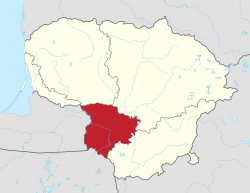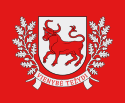Sudovia
Suvalkija Sūduva | |
|---|---|
| |
| Motto: Vienybė težydi (Let the unity blossom) | |
 Location of Sudovia within Lithuania | |
| Country | Lithuania |
| Capital and largest city | Marijampolė |
| Area | |
• Total | 5,794 km2 (2,237 sq mi) |
| • Excluding Aleksotas and Panemunė | 5,745 km2 (2,218 sq mi) |
| • Aleksotas and Panemunė | 49 km2 (19 sq mi) |
| Population (2021)[1] | |
• Total | 239,296 |
| • Excluding Aleksotas and Panemunė | 203,018 |
| • Aleksotas and Panemunė | 36,278 |
| Time zone | UTC2 (CET (GMT +2)) |
Suvalkija or Sudovia (Lithuanian: Suvalkija or Sūduva) is the smallest of the five cultural regions of Lithuania. Its unofficial capital is Marijampolė. People from Suvalkija (Suvalkijans, Suvalkians) are called suvalkiečiai (plural) or suvalkietis (singular) in Lithuanian.[2] It is located south of the Neman River, in the former territory of Vilkaviškis bishopric.[3] Historically, it is the newest ethnographic region as its most distinct characteristics and separate regional identity formed during the 19th century when the territory was part of Congress Poland.[4] It was never a separate political entity and even today it has no official status in the administrative division of Lithuania. However, it continues to be the subject of studies focusing on Lithuanian folk culture of the 19th and early 20th centuries.
Most of Lithuania's cultural differences blended or disappeared during the Soviet occupation (1944–1990), remaining the longest in southeastern Lithuania.[5] The concept remains popular among Lithuanian people. A 2008 survey of freshmen and sophomores (first- and second-year students) at Kaunas' Vytautas Magnus University found that 80% of the students continued to identify themselves with one of the regions.[6] Efforts are made to preserve, record, and promote any remaining aspects of the original folk culture.
- ^ "Nuolatinių gyventojų skaičius liepos 1 d.", osp.stat.gov.lt
- ^ Rywkin, Michael; Ronald Wixman (1982). The Peoples of the USSR: An Ethnographic Handbook. M.E. Sharpe. p. 181. ISBN 0-87332-506-0.
- ^ "Lietuvos etnogafinių regionų visuomeninės kultūros organizacijos". Žemaičių žemė (in Lithuanian). 4. 2002. ISSN 1392-2610. Archived from the original on 27 May 2011.
- ^ Cite error: The named reference
kudirkawas invoked but never defined (see the help page). - ^ Nakienė, Austė (2006). "Lietuvių muzikos tautiškumo problema. Pietryčių Lietuvos liaudies melodijos XX a. I pusės fonografo įrašuose" (PDF). Literatūra (in Lithuanian). 48 (5): 143–157. doi:10.15388/Litera.2006.5.8042. ISSN 0258-0802.
- ^ Venskienė, Asta (2008). "Lietuvos jaunimo etnografinis-lokalinis tapatumas XXI a.: geografinės apibrėžtys ir kilmė" (PDF). Lituanistica (in Lithuanian). 1 (73): 88–100. ISSN 0235-716X.





